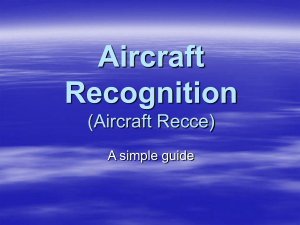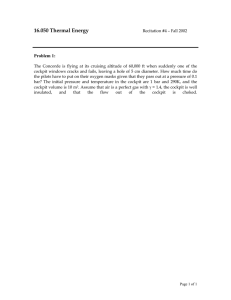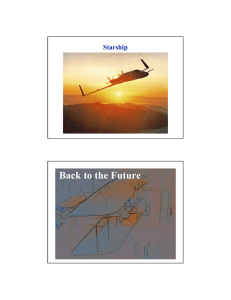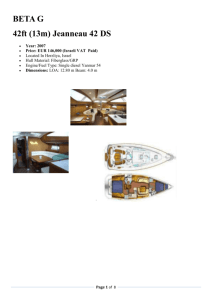Stress Analysis of Aircraft Fuselage Cockpit Floor
advertisement
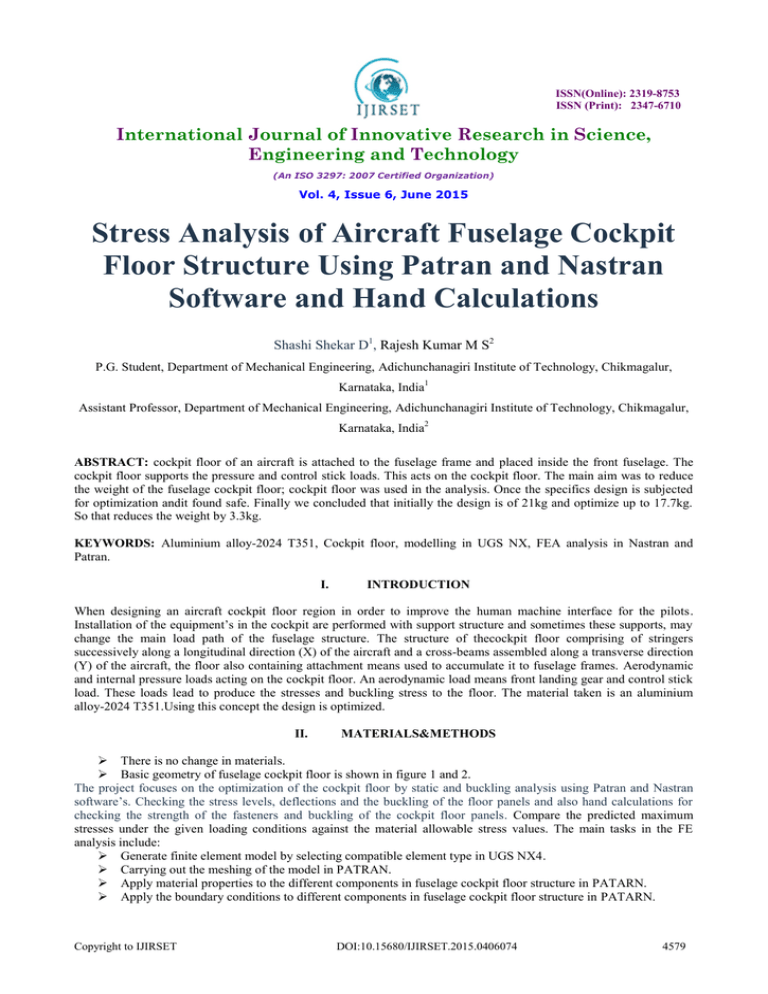
ISSN(Online): 2319-8753 ISSN (Print): 2347-6710 International Journal of Innovative Research in Science, Engineering and Technology (An ISO 3297: 2007 Certified Organization) Vol. 4, Issue 6, June 2015 Stress Analysis of Aircraft Fuselage Cockpit Floor Structure Using Patran and Nastran Software and Hand Calculations Shashi Shekar D1, Rajesh Kumar M S2 P.G. Student, Department of Mechanical Engineering, Adichunchanagiri Institute of Technology, Chikmagalur, Karnataka, India1 Assistant Professor, Department of Mechanical Engineering, Adichunchanagiri Institute of Technology, Chikmagalur, Karnataka, India2 ABSTRACT: cockpit floor of an aircraft is attached to the fuselage frame and placed inside the front fuselage. The cockpit floor supports the pressure and control stick loads. This acts on the cockpit floor. The main aim was to reduce the weight of the fuselage cockpit floor; cockpit floor was used in the analysis. Once the specifics design is subjected for optimization andit found safe. Finally we concluded that initially the design is of 21kg and optimize up to 17.7kg. So that reduces the weight by 3.3kg. KEYWORDS: Aluminium alloy-2024 T351, Cockpit floor, modelling in UGS NX, FEA analysis in Nastran and Patran. I. INTRODUCTION When designing an aircraft cockpit floor region in order to improve the human machine interface for the pilots. Installation of the equipment’s in the cockpit are performed with support structure and sometimes these supports, may change the main load path of the fuselage structure. The structure of thecockpit floor comprising of stringers successively along a longitudinal direction (X) of the aircraft and a cross-beams assembled along a transverse direction (Y) of the aircraft, the floor also containing attachment means used to accumulate it to fuselage frames. Aerodynamic and internal pressure loads acting on the cockpit floor. An aerodynamic load means front landing gear and control stick load. These loads lead to produce the stresses and buckling stress to the floor. The material taken is an aluminium alloy-2024 T351.Using this concept the design is optimized. II. MATERIALS&METHODS There is no change in materials. Basic geometry of fuselage cockpit floor is shown in figure 1 and 2. The project focuses on the optimization of the cockpit floor by static and buckling analysis using Patran and Nastran software’s. Checking the stress levels, deflections and the buckling of the floor panels and also hand calculations for checking the strength of the fasteners and buckling of the cockpit floor panels. Compare the predicted maximum stresses under the given loading conditions against the material allowable stress values. The main tasks in the FE analysis include: Generate finite element model by selecting compatible element type in UGS NX4. Carrying out the meshing of the model in PATRAN. Apply material properties to the different components in fuselage cockpit floor structure in PATARN. Apply the boundary conditions to different components in fuselage cockpit floor structure in PATARN. Copyright to IJIRSET DOI:10.15680/IJIRSET.2015.0406074 4579 ISSN(Online): 2319-8753 ISSN (Print): 2347-6710 International Journal of Innovative Research in Science, Engineering and Technology (An ISO 3297: 2007 Certified Organization) Vol. 4, Issue 6, June 2015 Apply the loads at appropriate locations such as pressure loads, control stick load and landing jack load in PATARN. Perform the finite element analysis by choosing appropriate solving methods in NASTRAN. Study and verify behaviour of the assembly under the given loads and boundary conditions in PATRAN. Figure 1: Top view of fuselage cockpit floor floorGeometry III. 1. FINITE ELEMENT ANALYSIS Assumptions for FEA 2. Figure 2:Front view of fuselage cockpit Geometry Accurate representation of complex geometry. Boundary conditions and loading are not restricted. Higher order elements may be implemented. Easy representation of the total solution. Model is easily refined for improved accuracy by varying element size & type. Time dependent and dynamic effects can be included. Loads and Boundary Conditions The pressure load has applied on the entire solid model is 7.7psi, control stickload acting on the floor is 1112 N and the front landing gear load acting on the cockpit floor is 3121.55 N. Boundary conditions are, Side frame members are fixed in 1, 2, 3 direction, skin attachments are fixed in 1 and 2 direction, edge wall are fixed in 1, 2, 3 directions, in plane frame is fixed in 1, 2 directions. Copyright to IJIRSET DOI:10.15680/IJIRSET.2015.0406074 4580 ISSN(Online): 2319-8753 ISSN (Print): 2347-6710 International Journal of Innovative Research in Science, Engineering and Technology (An ISO 3297: 2007 Certified Organization) Vol. 4, Issue 6, June 2015 3. Materials Table 1: Materials properties Aluminium Alloy-2024 T351 1. Young’s modulus=70000 N/mm2 1. Young’s modulus=2.1e5 N/mm2 2. Density= 2800 kg/mm2 2. Density= 7800 kg/mm2 3. Passion’s ratio= 0.3 3. Passion’s ratio= 0.3 4. Yield strength= 378 N/mm2 4. Yield strength= 1014.3 N/mm2 5. Ultimate stress= 485 N/mm2 5. Ultimate stress= 1035 N/mm2 IV. 1. Alloy steel Heat transfer A157 4340 RESULTS AND DISCUSSION Solid/CAD model of the fuselage cockpit floor:The figure shows the three dimensional aircraft fuselage cockpit floor. The geometry is built in sketcher and layer extruded to three dimensional parts in the part modeller to get three dimensional representations. Model is built using UGS NX4 software. Figure 3: Design Model of fuselage cockpit floor 2. FE model of fuselage cockpit floor: The figure shows the FE model of fuselage cockpit floor. It is built using MSC/PATRAN software. PATRAN is good meshing software to control the mesh at irregular geometries. Copyright to IJIRSET DOI:10.15680/IJIRSET.2015.0406074 4581 ISSN(Online): 2319-8753 ISSN (Print): 2347-6710 International Journal of Innovative Research in Science, Engineering and Technology (An ISO 3297: 2007 Certified Organization) Vol. 4, Issue 6, June 2015 Figure 4: FE model of fuselage cockpit floor 3. Detailed Quality checks of the Finite elements: Important quality issues like Aspect ratio, Skew angle, Warpage and Taper has to be verified and the values should not exceed allowable limit Verification for the boundary, duplicates are carried out. Normal for each element is assigned since it defines the thickness directions. The quality criteria are checked for meshed model of acceptable range to get accurate result. The detailed quality check data of the Finite elements is shown in figure. Figure 5:Detailed Quality checks of the Finite elements 4. Load and Boundary conditions of fuselage cockpit floor: These conditions are for the part has applied which shown in below figures. Boundary condition is a process of applying load and compelling the part. Boundary and load conditions figures are shown below. Copyright to IJIRSET DOI:10.15680/IJIRSET.2015.0406074 4582 ISSN(Online): 2319-8753 ISSN (Print): 2347-6710 International Journal of Innovative Research in Science, Engineering and Technology (An ISO 3297: 2007 Certified Organization) Vol. 4, Issue 6, June 2015 Figure 6:Boundary conditions for fuselage cockpit floor Figure 7: Pressure load on fuselage cockpit floor Figure 8: control stick and landing gear loads on fuselage cockpit floor Copyright to IJIRSET DOI:10.15680/IJIRSET.2015.0406074 4583 ISSN(Online): 2319-8753 ISSN (Print): 2347-6710 International Journal of Innovative Research in Science, Engineering and Technology (An ISO 3297: 2007 Certified Organization) Vol. 4, Issue 6, June 2015 5. Displacement plot of fuselage cockpit floor: Figure 9 shows the displacement of the fuselage cockpit floor when loads are applied on the fuselage cockpit floor. We observe that maximum displacement is 18.8mm at node 4651. Figure 9: Displacement plot for fuselage cockpit floor 6. Stress tensor plot for fuselage cockpit floor: Figure 10 shows the Stress tensor (von misses stress) plot for fuselage cockpit floor. When pressure 7.7psi is applied, control box load 1112 N and landing gear load 3121.55 N. Maximum stress observed is 3.48e2 at node 7820. Figure 10:Stress tensor plot for fuselage cockpit floor 7. Maximum and minimum principal stress plot for fuselage cockpit floor: Figures shows the Maximum and minimum principal stress developed on the fuselage cockpit floor. Maximum principal stress is 3.10e2 at node 7823 and minimum principal stress is -3.61e2 at node 5039. Copyright to IJIRSET DOI:10.15680/IJIRSET.2015.0406074 4584 ISSN(Online): 2319-8753 ISSN (Print): 2347-6710 International Journal of Innovative Research in Science, Engineering and Technology (An ISO 3297: 2007 Certified Organization) Vol. 4, Issue 6, June 2015 Figure 11:Maximum principal stress 8. Figure 12: Minimum principal stresses Maximum shear stress plot for fuselage cockpit floor: Figure 13 shows Maximum shear stress developed on the fuselage cockpit floor. Maximum shear stress is observed is 1.85e2 at node 7820. Figure 13: Maximum shear stress plot for fuselage cockpit floor 9. Buckling analysis for fuselage cockpit floor: For bucking analysis we constrained the boundary condition of the fuselage cockpit floor as same as the linear static analysis.to find the critical loads we have taken three iteration for buckling analysis and we got the results in last iteration. Figure shown given below. If load factor below 1 the model fuselage cockpit floor may buckle out.so we stop the iteration. Copyright to IJIRSET DOI:10.15680/IJIRSET.2015.0406074 4585 ISSN(Online): 2319-8753 ISSN (Print): 2347-6710 International Journal of Innovative Research in Science, Engineering and Technology (An ISO 3297: 2007 Certified Organization) Vol. 4, Issue 6, June 2015 Figure 14: Buckling analyses for fuselage cockpit floor Table 2:Interpretation of the Buckling Load Factor BLF Value >1 =1 Buckling Status Buckling not predicted Buckling predicted <1 Buckling predicted ‐1 < BLF < 0 ‐1 Bucklin possible Buckling possible <‐1 Buckling not predicted V. The applied loads are less than the estimated critical loads, Even if you reverse their directions. CONCLUSION The linear static analysis as well as buckling analysis of fuselage cockpit floor for a given loads and boundary condition is analysed. Further optimization studied carried out to get the optimal weight and the finite element shows the structure is safe for a strength consideration The stresses in the component keeps increased as the thickness of the model reduce. The maximum stress occurs around the loads acting on the model. VI. Remarks The applied loads are less than the estimated critical loads. The applied loads are exactly equal to the critical loads. Buckling is expected. The applied loads exceed the estimated critical loads. Buckling will occur. Buckling is predicted if you reverse the load directions. Buckling is expected if you reverse the load directions. SCOPE OF FUTURE WORK In future, using different material for fuselage cockpit floor can be studied. In future, using composite material to reduce the weight and it can be studied for different analysis. In future, it can be studied for different design of aircrafts. Copyright to IJIRSET DOI:10.15680/IJIRSET.2015.0406074 4586 ISSN(Online): 2319-8753 ISSN (Print): 2347-6710 International Journal of Innovative Research in Science, Engineering and Technology (An ISO 3297: 2007 Certified Organization) Vol. 4, Issue 6, June 2015 REFERENCES [1] Marco Aurelio Rossi, SérgioFrascino Müller de Almeida DESIGN AND ANALYSIS OF A COMPOSITE FUSELAGE. 2009 Brazilian Symposium on Aerospace Eng. & Applications September 14-16, 2009, S. J. Campos, SP, Brazil. [2] MarampalliShilpa*, M. Venkateswar Reddy, Dr. A. Siva Kumar Design & Analysis of Fuselage Structure using Solidworks& ANSYS ISSN: 2277-9655 September, 2014. [3] Achyutha Krishna Rao K, AkashMohanty and Shiva Rama Krishna, A Finite Element Modeling And Analysis Of Fuselage Stiffened Panel Subjected To Cabin Pressurization, ICAMB 2012, and Jan 9-11, 2012. [4] SrirangaB.k, Kumar .R STRESS ANALYSIS AND FATIGUE LIFE PREDICTION OF WING- FUSELAGE LUG JOINT ATTACHMENT BRACKET OF A TRANSPORT AIRCRAFT, eISSN: 2319-1163 | pISSN: 2321-7308. [5] A.Rukesh Reddy, 2,P. Ramesh, ,B. Siddeswararao, Stress Analysis of Splice Joint of the Aircraft Bottom Wing Skin by Finite Element Method International Journal of Computational Engineering Research, Volume 03, Issue, 11. Copyright to IJIRSET DOI:10.15680/IJIRSET.2015.0406074 4587
